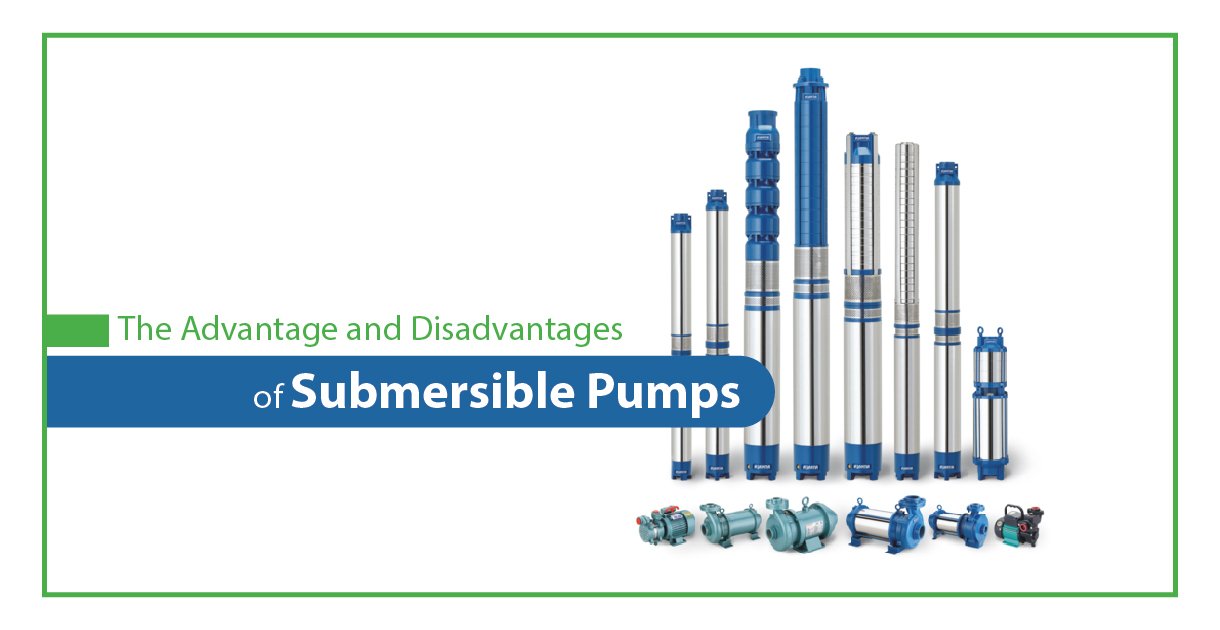Considering a submersible pump? Learn its advantage and disadvantages before deciding. Submersible pumps are designed to be submerged in the liquid they pump, making them efficient and reliable for a variety of applications. They operate quietly and without vibration, making them ideal for noise-sensitive locations. However, they can be expensive to install and maintain due to their submerged location and specialized equipment requirements. Knowing their benefits and drawbacks can help you make an informed decision that suits your needs and budget. Let us explore the world of submersible pumps together.
Advantages of submersible pumps
- Efficiency: Submersible pumps are highly efficient because they are submerged in the fluid they are pumping. This eliminates the need to prime the pump, reduces energy consumption, and increases overall pumping efficiency.
- Space-Saving: These pumps are compact and don’t require a lot of space. They can be submerged in a well or tank, saving valuable surface space.
- Low Noise: Submersible pumps are quieter compared to some other types of pumps, which is especially important for residential applications.
- Reliability: Submersible pumps are less prone to cavitation (the formation of bubbles in the fluid) because they are always submerged. This makes them more reliable and less likely to fail prematurely.
- Maintenance: They typically require less maintenance compared to other types of pumps, reducing the cost and time needed for upkeep.
- No Priming Required: Submersible pumps don’t need priming, which simplifies the installation process.
- Versatility: They can handle a wide range of fluids, from clean water to sewage, depending on the pump’s design.
Disadvantages of submersible pumps
- Installation Complexity: Installing submersible pumps can be more complex compared to above-ground pumps, as it requires the creation of a well or tank to submerge the pump.
- Cost: Submersible pumps can be more expensive upfront compared to some other types of pumps. The installation costs can also be higher due to the required well or tank.
- Maintenance Accessibility: While they generally require less maintenance, accessing and servicing a submersible pump can be challenging and may require specialized equipment.
- Limited to Liquid: Submersible pumps are designed for liquids and can be damaged if they run dry. They should not be used for pumping air or dry materials.
- Weight: The weight of submersible pumps can be significant, making handling and installation more challenging.
- Sizing and Selection: Proper sizing and selection of a submersible pump are critical. If not sized correctly, it can lead to inefficiency or premature failure.
- Environmental Concerns: In some cases, there may be environmental concerns related to the fluid being pumped, especially when dealing with hazardous or toxic materials.
Types of submersible pumps
Submersible pumps come in various types, each designed for specific applications. The most common types include:
- Submersible well pumps: These pumps are specifically designed for deep well water extraction. They are capable of pumping water from great depths and are commonly used in residential, agricultural, and industrial applications. Submersible well pumps are available in different capacities to accommodate varying well depths.
- Submersible sump pumps: Sump pumps are used to remove water from basements, crawl spaces, and other areas prone to flooding. Submersible sump pumps are designed to be installed in a sump pit or basin, where they automatically activate to pump out excess water. They are equipped with float switches that detect rising water levels and start the pump when needed.
- Submersible sewage pumps: These pumps are specifically designed to handle wastewater and sewage with solids. They are commonly used in residential, commercial, and municipal applications for sewage and effluent pumping. Submersible sewage pumps are capable of handling high volumes of water with solids and are designed to prevent clogging or damage.
- Submersible utility pumps: Utility pumps are versatile pumps used for a wide range of applications, including draining swimming pools, removing standing water, and transferring liquids. Submersible utility pumps are portable and easy to use, making them ideal for temporary or emergency pumping needs.
Applications of submersible pumps
Submersible pumps have a wide range of applications across various industries and settings. Some common applications include:
- Water supply and irrigation: Submersible well pumps are commonly used for water supply in residential, agricultural, and industrial settings. They efficiently pump water from deep wells or water sources to supply water for domestic use, irrigation, livestock watering, and other purposes.
- Flood control and drainage: Submersible sump pumps are essential for preventing flooding in basements, crawl spaces, and other areas prone to water accumulation. They effectively remove excess water, preventing property damage and mould growth.
- Wastewater and sewage management: Submersible sewage pumps are used for the management and disposal of wastewater and sewage in residential, commercial, and municipal settings. They efficiently pump sewage and effluent to treatment facilities or septic systems.
- Construction and dewatering: Submersible pumps are commonly used in construction sites for dewatering excavations, tunnels, and basements. They help remove water from these areas, allowing construction work to proceed efficiently and safely.
Maintenance and troubleshooting tips for submersible pumps
To ensure optimal performance and longevity of your submersible pump, regular maintenance is essential. Here are some maintenances and troubleshooting tips to keep in mind:
- Regular inspections: Inspect the pump regularly for any signs of leaks, damage, or debris accumulation. Check the power supply, controls, and connections for any issues. Address any problems promptly to prevent further damage.
- Cleaning: Clean the pump and remove any debris or sediment that may have accumulated around or inside the pump. This will prevent clogging and ensure smooth operation.
- Replace worn parts: Regularly check the condition of the pump’s seals, impellers, and bearings. Replace any worn or damaged parts to maintain optimal performance.
- Check the power supply: Ensure that the pump is getting a consistent and sufficient power supply. Check the electrical connections, switches, and fuses to ensure they are functioning properly.
- Monitor performance: Keep track of the pump’s performance, including flow rate, pressure, and efficiency. Any significant changes or deviations from the normal operating parameters may indicate a problem that needs to be addressed.
Comparing submersible pumps to other types of pumps
When considering a submersible pump, it is important to compare it to other types of pumps to determine the best choice for your application. Here are some key points of comparison:
- Efficiency: Submersible pumps are generally more efficient due to their direct immersion in the fluid being pumped. Surface pumps may require long suction hoses or priming, which can result in energy loss and reduced efficiency.
- Power and capacity: Submersible pumps are typically more powerful and capable of handling larger volumes of water compared to surface pumps. Surface pumps may be more suitable for smaller-scale applications or when higher pressure is required.
- Installation and maintenance: Submersible pumps may require professional installation due to their submersion in water. Surface pumps are generally easier to install and maintain.
- Durability: Submersible pumps are designed to be more durable and long-lasting due to their protected position underwater. Surface pumps may be more susceptible to damage from weather conditions and external elements.
Cost considerations of using submersible pumps
The cost of using submersible pumps includes several factors to consider:
- Initial cost: Submersible pumps generally have a higher initial cost compared to other types of pumps. This includes the purchase price of the pump itself.
- Installation cost: If professional installation is required, this adds to the overall cost. Installation may involve additional equipment, labour, and materials.
- Maintenance cost: Regular maintenance and inspection of submersible pumps are essential for optimal performance and longevity. Factor in the cost of spare parts, servicing, and any potential repairs.
- Energy consumption: Submersible pumps require a constant power supply, which can result in higher energy consumption compared to surface pumps. Consider the long-term energy costs associated with using a submersible pump.
Conclusion:
In conclusion, submersible pumps offer several advantages such as efficiency, power, and durability. They are well-suited for a wide range of applications including water supply, flood control, wastewater management, and construction dewatering. However, they also come with considerations such as higher initial cost, installation complexity, and maintenance requirements.
Before deciding, evaluate your specific needs, budget, and the nature of your application. Consider the pros and cons discussed in this article, as well as the factors to consider before choosing a submersible pump. By carefully assessing your requirements and weighing the advantages and disadvantages, you can determine whether a submersible pump is the right choice for you.
If you are in need of high-quality submersible pump parts in Ahmedabad, look no further than Micro Care Group. Their products are top-of-the-line!


